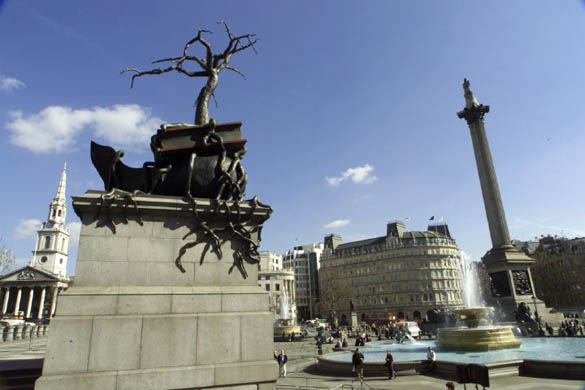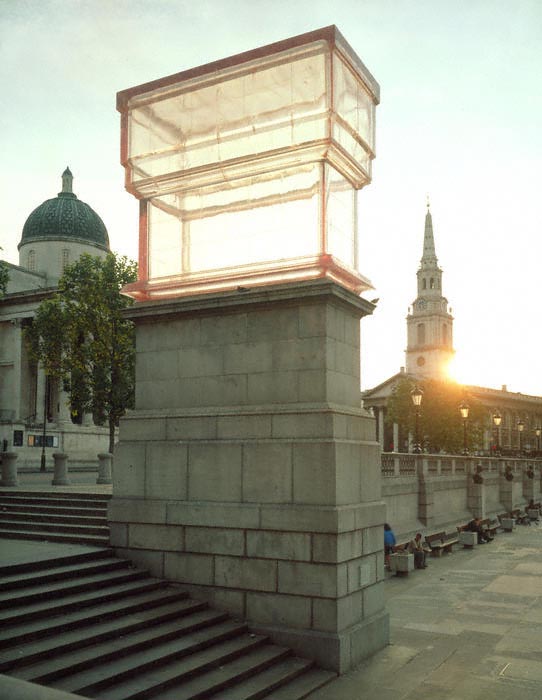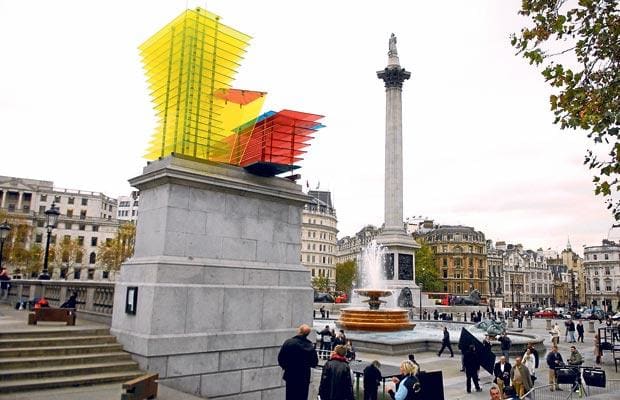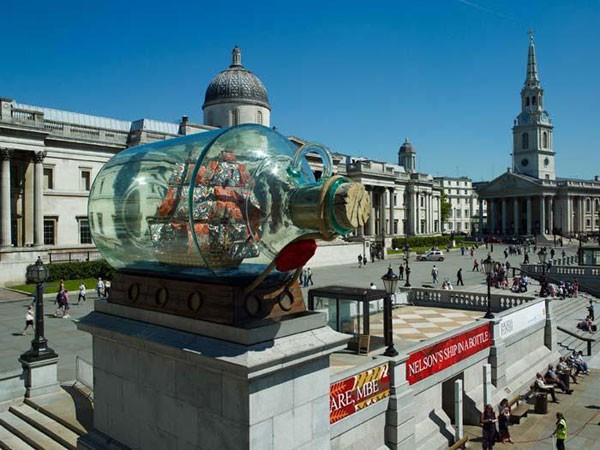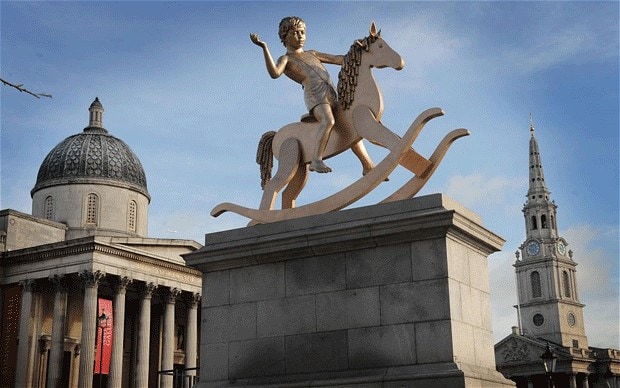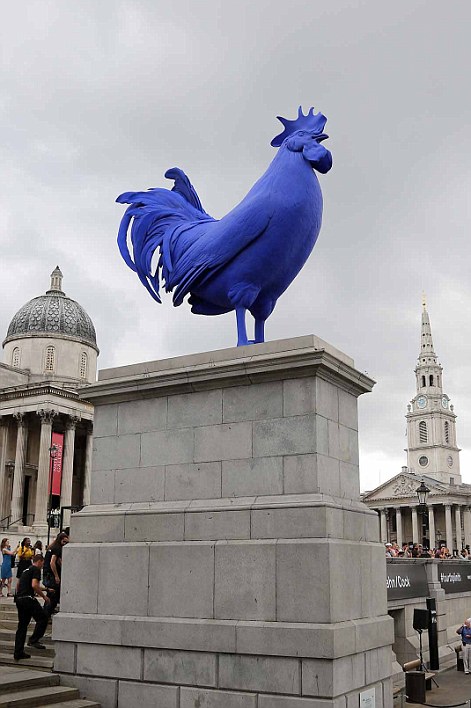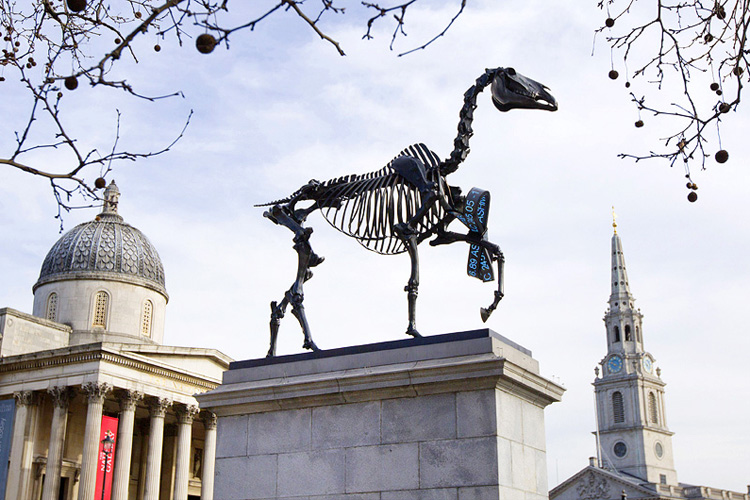Difference between revisions of "Significance of London's Fourth Plinth"
From Londonhua WIKI
(→Section 2: Deliverable) |
(→Section 2: Deliverable) |
||
| Line 61: | Line 61: | ||
==The Fourth Plinth's significance to Trafalgar Square== | ==The Fourth Plinth's significance to Trafalgar Square== | ||
<br> | <br> | ||
| − | + | The following is a argumentative essay discussing the Fourth Plinth's contribution to the significant influence of the public on Trafalgar Square. | |
| + | [[Trafalgar_Square's_Fourth_Plinth.pdf|See More]] | ||
| + | <br><br> | ||
All public open spaces face the issue of striking a balance between what the space was meant for and how the public at large seeks to use it. This tension pervades parks, street sidewalks, and so on, with Trafalgar Square being no exception. As investigated in this milestone's background, the square has a long and turbulent history as a space known as the meeting place for the general public to meet London's state authority on government owned land. As a place was established as such a hybrid, Owned and operated by those in power and, at the same, used by everyone, It was destined to serve as a broad representation of the nation as a whole. These tensions have only transformed and rooted themselves more deeply into the identity of Trafalgar Square. The paradoxical nature of Trafalgar Square, as a place dedicated to tradition and Imperial nationalism having served so often as a platform for questioning authority and progressive demonstration, makes the square the perfect representation of London and Londoners as a whole.<br><br> | All public open spaces face the issue of striking a balance between what the space was meant for and how the public at large seeks to use it. This tension pervades parks, street sidewalks, and so on, with Trafalgar Square being no exception. As investigated in this milestone's background, the square has a long and turbulent history as a space known as the meeting place for the general public to meet London's state authority on government owned land. As a place was established as such a hybrid, Owned and operated by those in power and, at the same, used by everyone, It was destined to serve as a broad representation of the nation as a whole. These tensions have only transformed and rooted themselves more deeply into the identity of Trafalgar Square. The paradoxical nature of Trafalgar Square, as a place dedicated to tradition and Imperial nationalism having served so often as a platform for questioning authority and progressive demonstration, makes the square the perfect representation of London and Londoners as a whole.<br><br> | ||
From its initial conception following English victory at the famous Battle of Trafalgar, Trafalgar square was intended as a place to pay tribute to men like Admiral Nelson and the like, as well as the country they fought and died for. While this commission of this land for such a memorial was admirable, the choice to build a monument and square representative of English Imperial power was a decision clearly calculated to send a message to, not only Londoners, but to the world as well. Reminiscent of a Roman forum, Trafalgar Square's defining feature just south of the square's center sits Nelson's Column. As a column of corinthian order, Nelson's figure stands atop it leaning on his sword adopting a pose clearly reminiscent of Napoleon, utilizing it as a simple pedestal. Having been built in first half of the 19th century, as England emerged on the world stage touting imperial superiority. As a monument to such deliberate nationalism would prove trite if displayed on private land, Trafalgar Square stands out as a public space designed as essentially propaganda to the masses. What the square planners failed to see was that a place such as the square would not so much influence Londoner, but rather, how London's public would take shaping the square's identity into their own hands.<br><br> | From its initial conception following English victory at the famous Battle of Trafalgar, Trafalgar square was intended as a place to pay tribute to men like Admiral Nelson and the like, as well as the country they fought and died for. While this commission of this land for such a memorial was admirable, the choice to build a monument and square representative of English Imperial power was a decision clearly calculated to send a message to, not only Londoners, but to the world as well. Reminiscent of a Roman forum, Trafalgar Square's defining feature just south of the square's center sits Nelson's Column. As a column of corinthian order, Nelson's figure stands atop it leaning on his sword adopting a pose clearly reminiscent of Napoleon, utilizing it as a simple pedestal. Having been built in first half of the 19th century, as England emerged on the world stage touting imperial superiority. As a monument to such deliberate nationalism would prove trite if displayed on private land, Trafalgar Square stands out as a public space designed as essentially propaganda to the masses. What the square planners failed to see was that a place such as the square would not so much influence Londoner, but rather, how London's public would take shaping the square's identity into their own hands.<br><br> | ||
Revision as of 12:19, 22 June 2017
Significance of London's Fourth Plinth
by Cole Fawcett
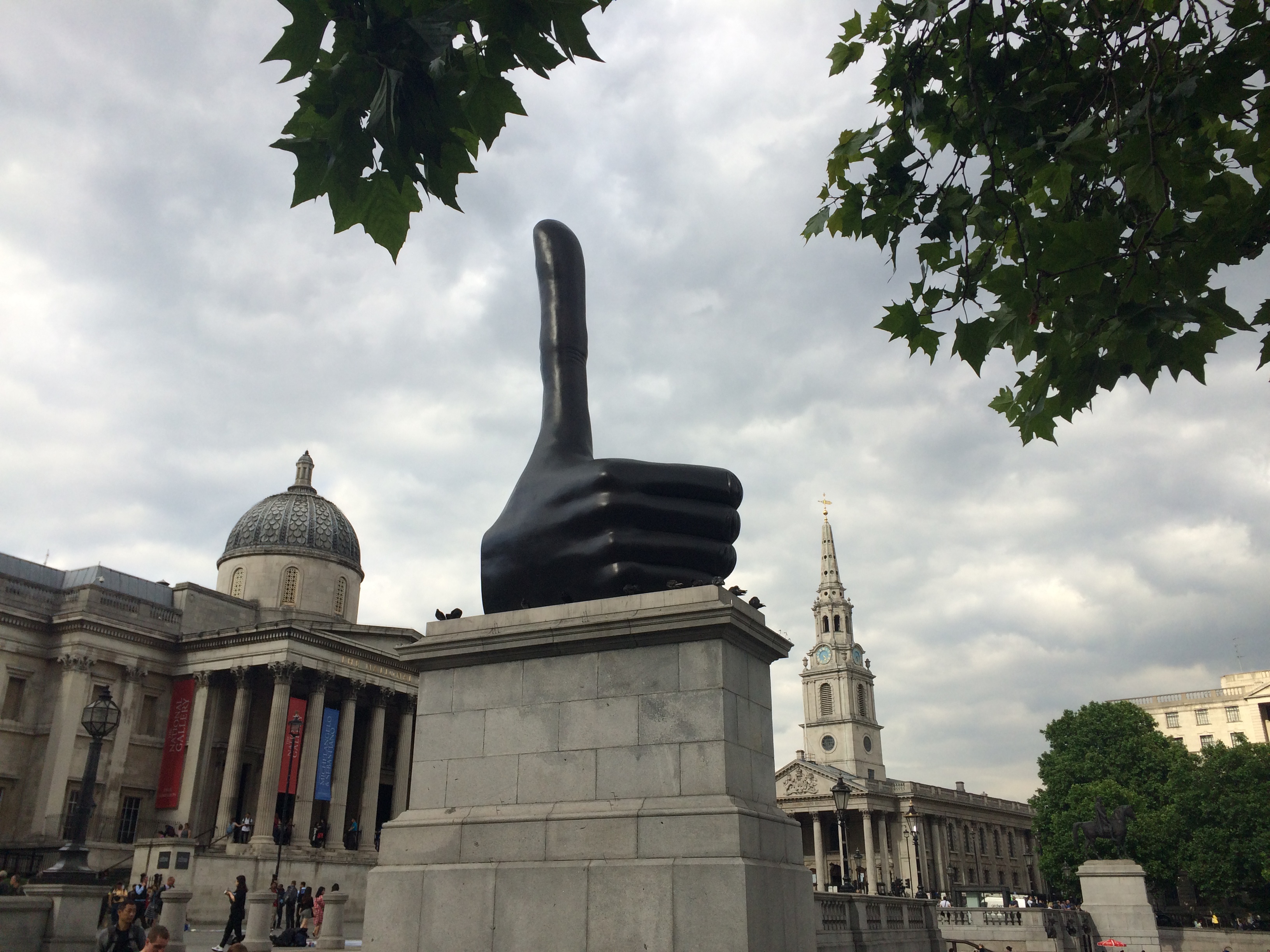 The Fourth Plinth, displaying its most recent commission, Really Good by David Shrigley |
Contents
Abstract
This milestone analyzed Trafalgar Square's Fourth Plinth and its art commissions as a response to what the square has traditionally stood for. The background consisted of research on the History of Trafalgar Square and the Fourth Plinth's development as one of the worlds smallest contemporary art exhibitions, one piece at a time. My deliverable section of this milestone was a inspired paper on the role of the Fourth plinth in contrasting Trafalgar Square's Imperial original intent and its history of public use to answer the question of whether Trafalgar Square aptly represents London's modern morals and character. Overall, this project to sheds light on how art can saw more about its surroundings than itself and enable us to critically observe our environment.
Introduction
This milestone studies the history behind London's Fourth Plinth and the unique role the plinth plays as a part of Trafalgar Square. I wanted to look at how and why the Fourth Plinth's art commissions, beginning in 1999 running to the present, have continued to raise discussion and debate. While some historians have analyzed Trafalgar Square's relationship to activism and public demonstration, and journalists and editors have investigated the reactions and significance of the Fourth Plinth's commissions, through this milestone I committed to examining the intersectionality between these two studies, supported by a rich historical context. Much of work consisted of finding reputable sources overing the contemporary works exhibited on Trafalgar Square's Fourth Plinth and effectively creating a coherent history of the Fourth Plinth, from its construction in 1841 to the 20st century.
Section 1: Background
History of Trafalgar Square
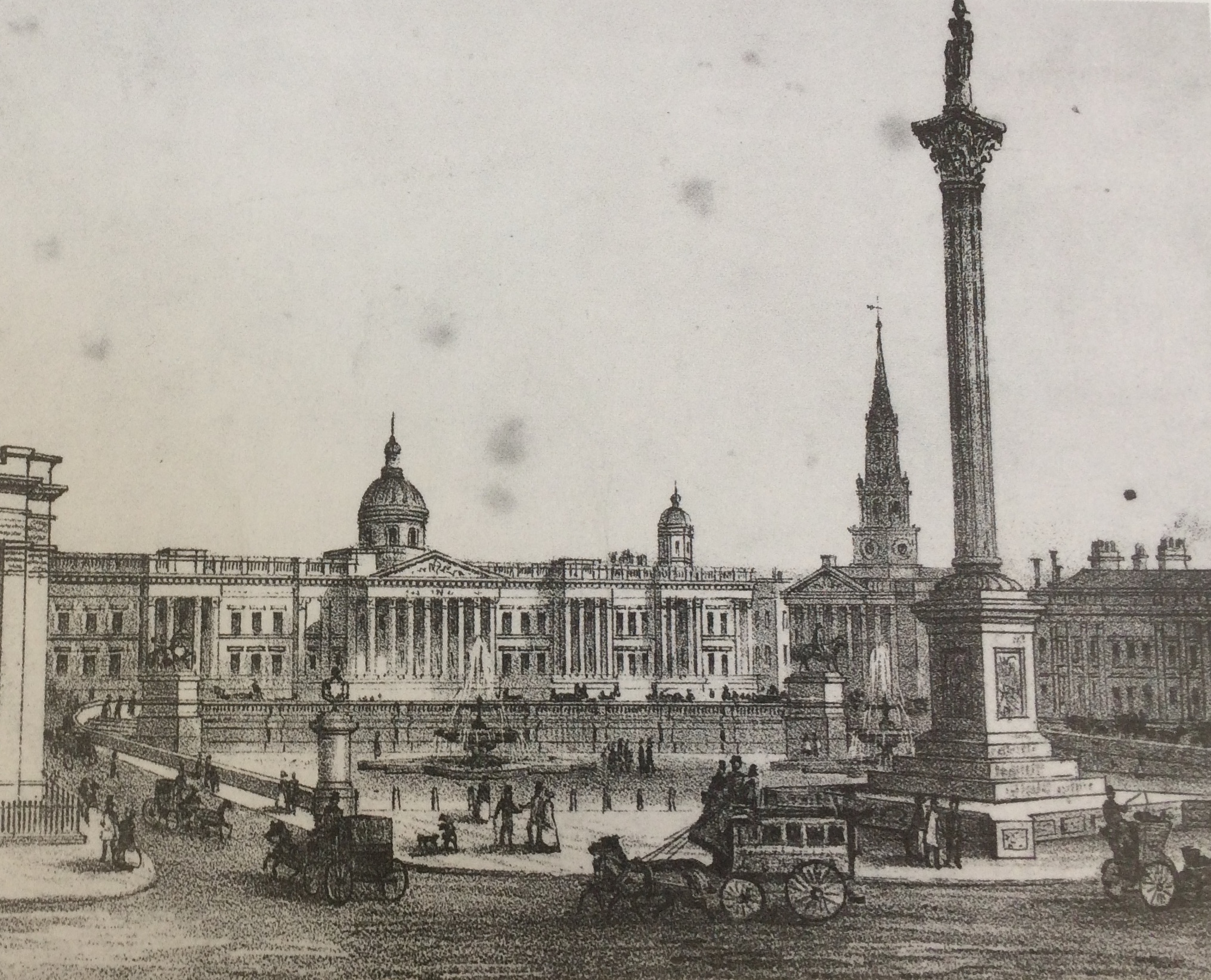
Trafalgar Square stands in a unique position as a public space in London. The squares signature monuments of George IV on horseback and Nelson's column exude an expression of the country's social and political aspirations. Trafalgar Square intentions was to inspire nationalistic fervor and command international reverence. The square was originally intended as a showpiece, a place to look at and show off to local and foreign eyes alike. Places like trafalgar square, places that serve as their own countries signs of pride, all embody the attitudes and morals of the ruling class, deciding what of and how history is remembered. This interplay between the aristocratic intention and public use would help shape and define Trafalgar square as a place of heated debate, over time fostering a microcosm of the nations political, economic, and ethical issues.
The infighting event for the erection of Trafalgar Square occurred on the 21st of October, 1805; the last sea battle of Britain's war with France, appropriately known as The Battle of Trafalgar. Britain's victory established the country as the number one global sea power, sowing the seeds of the establishment of British Empire over the next 100 years. With the death of Admiral Horatio Nelson at such a fortuitous battle, desire for monument to celebrate the battle's Admiral grew. Despite this eagerness, it would take 35 years after Nelson's death for the land outside the south entrance of the National Gallery, just north of the center of London at Charing Cross, to be designated as Trafalgar Square and decided on as the spot for Nelson's honorary "national monument." The actual construction of the square itself took place during 1842 and 1843, running into significantly less problems than the planning and decision-making behind Nelson's monument.[2] Besides Trafalgar Square's signature column, four plinths punctuate each corner of the square. The first, a bronze statue commemorating the late George IV, was installed on the squares eastern plinth in 1844. The two plinths on the south side of Trafalgar Square came in the late 19th century, funded by public subscriptions to the square, both depicting famous English war heroes. The south-west plinth was erected first in 1855-6 adorned by a bronze statue of General Sir Charles James Napier. The south-east plinth came five years later in 1861, topped with a bronze Major-General Sir Henry Havelock. [3]The so-called fourth plinth, located on Trafalgar Squares north-west corner, was originally built in 1841 to display a sculpture of William IV, but due to lack of funding remained empty all the way up until the very end of the 20th century in 1999.
Protest and Demonstration in Trafalgar Square
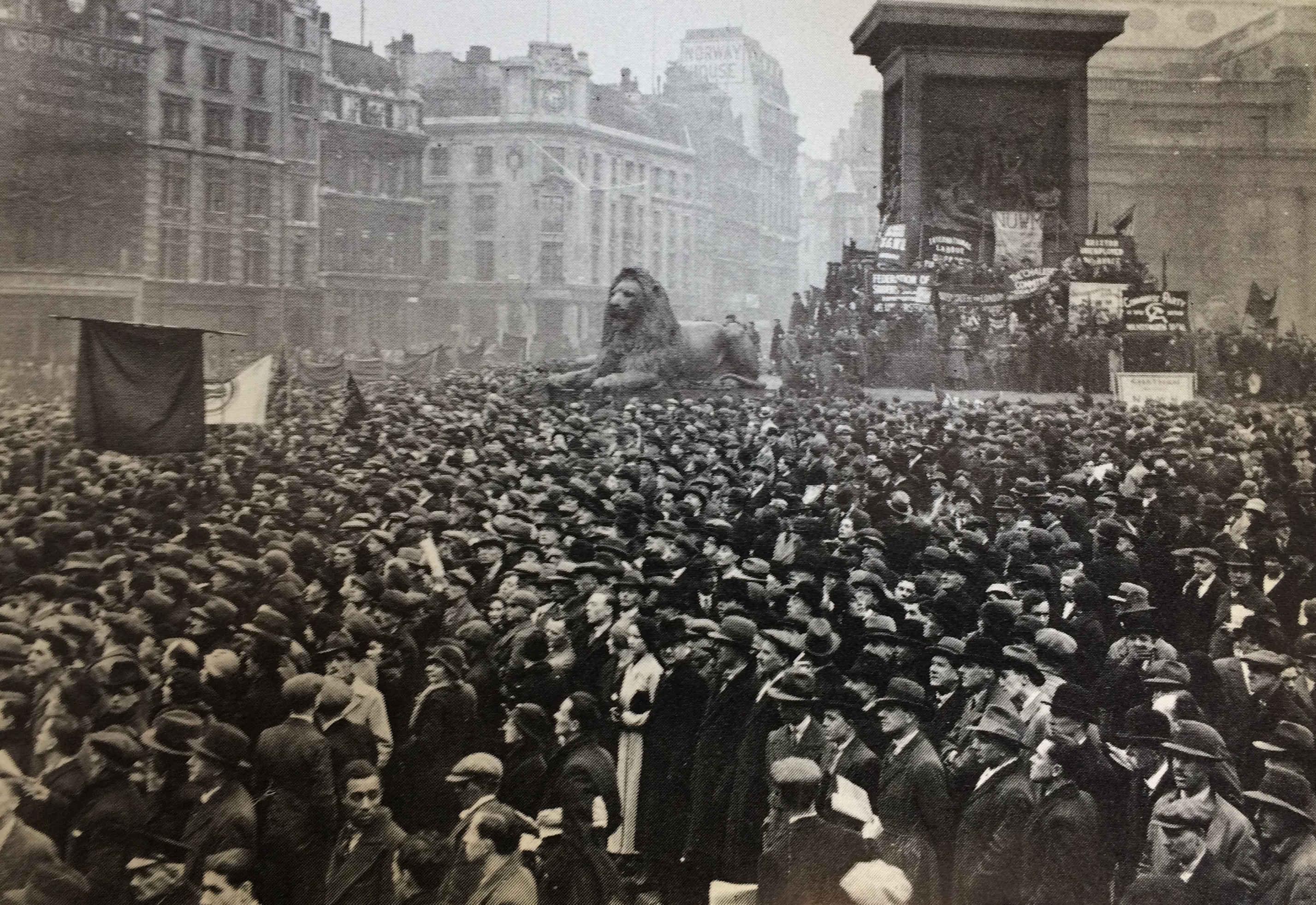
The land where Trafalgar square rests today has long been a politically charged forum for the "State" and "People" to voice their grievances and sometimes celebrate. Entering the 19th century, poor working conditions, urban and rural poverty, and middle class dissension took to the streets in increasingly organized fashion, finding trafalgar square a suitable place for, what was considered at the time,"riotous assembly". While much of rioting and outbreaks of public disorder became infrequent as the economy's upswing after 1850 saw a raised standard of living for the majority of the population, Trafalgar Square continued to serve as a place of meeting and a platform for public demonstration into the 20th century. Political unrest rose in London between 1887 and 1892 with an increased public focus on 'the Troubles', a political, nationalistic conflicted over the northern irelands sovereignty. The incident that came to be known as Bloody Sunday saw protests at Trafalgar Squared turn from hostile to violent police intervention. After such a unsightly event in the square, police oversight increased to assure civil order in and around Trafalgar Square.

At the turn of the 20th century, the square proved a ideal mass outdoor public meeting place to organize and demonstrate against inequality and injustice. Suffragettes took to the square seeking a forum to let their message be heard. In a period of twenty years following World War I, much of the demonstrations in Trafalgar Square reflected the two dominant issues that faced the Labour movement: unemployment, and the fight against fascism. Demonstration in Trafalgar square frequently met high tension from London police enforcement. Undeterred, campaigns for Nuclear disarmament, anti-war campaigns, and free speech protests pervaded the gatherings in Trafalgar square into the 21st century.[6] The Seventies saw Anti-Apartheid rallies and Gay and Lesbian Rights activism. Poll tax riots dominated the square in the Nineties. Calls and signs protesting against America's Second Iraq war displayed beneath Nelson's Column in 2003.
[7]
The Fourth Plinth

Following its initial construction in 1841, more than 150 years passed with the plinth remaining completely desolate. Not until 1985, would any effort be made to fill this seemingly incomplete aspect of a square so prevalent as a part of London. The Royal Society of Arts(RSA)'s then Directer, Prue Leith, took the initiative to poll the public for nominations on what should populate Trafalgar Square's empty fourth plinth, reigniting a conversation not seriously considered in over a century.[9] After the results had came in, the RSA eventually came to the consensus that there simply wasn't a single piece of art that could aptly represent and take up such a permanent famous location. The Fourth Plinth Project, starting in 1999, served as the RSA's compromise. The plan, rather than commissioning one permanent statue sought to subvert expectation, sought to changing the plinth into exhibition sit with a series of successive contemporary works of art, starting with three pieces by three separate artists. Through this, the RSA successfully cemented the ideals of change and evolution in a place previously exclusive in stressing only tradition and reverence to the past. This solution also didn't solve the dilemma directly but rather exposed it and left the question of what ought to fill such a void left empty for so long. The works exhibited on Trafalgar Square's Fourth Plinth, as expected and intended, come accompanied with controversy. [10]Two works stand out of the Fourth Plinth commission's eleven separate pieces as inciting particular critique: Mark Wallinger's Ecce Homo and Marc Quinn's Alison Lapper Pregnant.
Ecce Homo
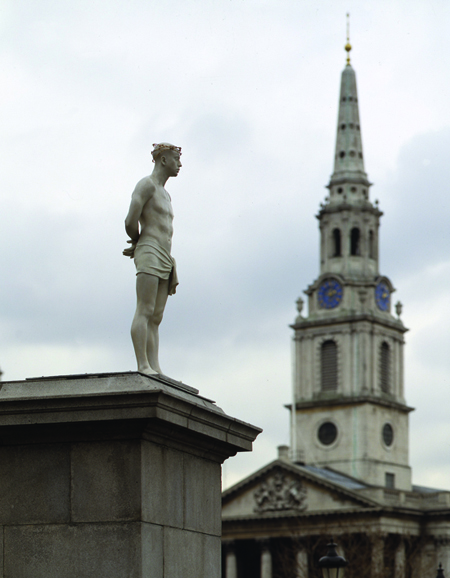
As the Fourth Plinth Project's first commission, Ecce Homo aspired to be the first sculpture to fill Trafalgar Square's 158 years famous empty plinth. The sculpture, as pictured on the right, depicts the chalk-white figure of Jesus Christ, shaved, wearing only a simple cloth around his waist and a gold crown of thorns. The figures size and blatant representation, by itself, are subversive and striking. Reactions from critics ranged from Sir Roy Strong, former director of the V&A Museum and National Portrait Gallery, proclaiming,
"Is it right for Trafalgar Square? The answer must be a resounding No. That square is a great secular pantheon celebrating Britain's imperial glories... Only people totally ignorant of the square's very definite theme could have chosen something so glaringly inappropriate" to Richard Dorment, an Art Critic of the London's Daily Telegraph. Dorment commented on Ecce Homo, saying, "Disparity in scale between plinth and figure is, like the setting of Trafalgar Square, as important to the meaning of the work as the figure itself. In its exultation of humility, of suffering and of acceptance, it questions the values by which we live our lives. Instinctively we contrast this human-scaled Christ with the giant figures of Sir Charles Napier and General Havelock nearby. Admiral Nelson has been raised on his column so high above mortal men that he is almost invisible... Wallinger's Christ seems to rebuke a city that exalts [Nathan's Column along with the three remaining plinths].. To commission the first work in the series from one of the quirkiest figures in British art...took courage and imagination."
Penny Egan, Director of RSA, noted how such a work stimulated the public attention about public art and, in so doing, revealed society's strengths and core values. She went on to state the Fourth Plinth project was intended to raise the debate about contemporary sculpture in public places. "The fact that we finally have an occupant on the empty plinth is significant in itself." Starting with a humble representation of Christianity's messiah succeeded in set the precedent of inciting debate and controversy in the Fourth Plinth Projects first commission. Wallinger's sculpture made sure the Fourth Plinth Commissions pushed to demonstrate and make statements using Trafalgar Square as a platform.
[12]
Alison Lapper Pregnant

Following the Fourth Plinth Project's original line up of Mark Wallinger's Ecce Homo, Bill Woodrow's Regardless of History, and Rachel Whiteread's Monument, the project was considered successful and it was agreed and, "unanimously recommended that the plinth should continue to be used for an ongoing series of temporary works of art commissioned from leading national and international artists."[14] The Fourth Plinth's fourth commission came in September 2005 in the form of Marc Quinn's Alison Lapper Pregnant. The piece, pictured right, consists simply of a white marble carved sculpture of Alison Lapper, a reputed English artist born without arms and shortened legs, a condition known as phocomelia.[15] Lapper was eight months pregnant when Quinn took the cast of her. [16]When Alison Lapper Pregnant was announced as the sculpture that would mark the Fourth Plinth Commission's continuation in Trafalgar Square, response varied wildly. While Quinn saw this sculpture as a deliberate counterbalance to "the heavy presence of military images in statues across London, others disagreed with its commission. , "I dislike the Quinn intensely... It's a gloriously fudged decision and they better try and get it right next time.", London's Evening Standard's art critic Brian Sewell stated blatantly. Editor of art magazine The Jackdaw, David Lee, went so far as to call the piece "Ghasty." At the same time however, Jay Jopling, founder of White Cube Gallery which exhibited Quinn, commented on the criticism Alison Lapper Pregnant faced, saying, "I don't see how anyone could find this work sensationalist. It's a major work of art, drawing on tradition and context, very rich and layered." Bert Massie, Chairman of the Disability Rights Commission, wished, "Congratulations to Marc for realizing that disabled bodies have a power and beauty rarely recognized in an age where youth and 'perfection' are idolized."Sandy Nairn, then Director of the National Portrait Gallery, commented on public response to commissions: "At the end of the day it was an artistic judgement."[17] Alison Lapper Pregnant was commissioned proudly atop the Fourth Plinth for 18 months, from the fifteenth of September, 2005 to the fifth of October, 2007.[18]
Section 2: Deliverable
The following is a argumentative essay discussing the Fourth Plinth's contribution to the significant influence of the public on Trafalgar Square.
The Fourth Plinth's significance to Trafalgar Square
The following is a argumentative essay discussing the Fourth Plinth's contribution to the significant influence of the public on Trafalgar Square.
See More
All public open spaces face the issue of striking a balance between what the space was meant for and how the public at large seeks to use it. This tension pervades parks, street sidewalks, and so on, with Trafalgar Square being no exception. As investigated in this milestone's background, the square has a long and turbulent history as a space known as the meeting place for the general public to meet London's state authority on government owned land. As a place was established as such a hybrid, Owned and operated by those in power and, at the same, used by everyone, It was destined to serve as a broad representation of the nation as a whole. These tensions have only transformed and rooted themselves more deeply into the identity of Trafalgar Square. The paradoxical nature of Trafalgar Square, as a place dedicated to tradition and Imperial nationalism having served so often as a platform for questioning authority and progressive demonstration, makes the square the perfect representation of London and Londoners as a whole.
From its initial conception following English victory at the famous Battle of Trafalgar, Trafalgar square was intended as a place to pay tribute to men like Admiral Nelson and the like, as well as the country they fought and died for. While this commission of this land for such a memorial was admirable, the choice to build a monument and square representative of English Imperial power was a decision clearly calculated to send a message to, not only Londoners, but to the world as well. Reminiscent of a Roman forum, Trafalgar Square's defining feature just south of the square's center sits Nelson's Column. As a column of corinthian order, Nelson's figure stands atop it leaning on his sword adopting a pose clearly reminiscent of Napoleon, utilizing it as a simple pedestal. Having been built in first half of the 19th century, as England emerged on the world stage touting imperial superiority. As a monument to such deliberate nationalism would prove trite if displayed on private land, Trafalgar Square stands out as a public space designed as essentially propaganda to the masses. What the square planners failed to see was that a place such as the square would not so much influence Londoner, but rather, how London's public would take shaping the square's identity into their own hands.
As touched on in the project background, Trafalgar Square was not stranger to public demonstration. Just north of London's center, Charing Cross[19], the land where Trafalgar Square was established has long been fraught with civil demonstration through protests and riots. While the designers and planners behind Trafalgar Square may have intended for and believed that such activism would decrease or disappear from the area by defining it as a place of national pride, quite the opposite came about a result. Trafalgar Square with its wide-open shape and location near the heart of London fortuitously served as the perfect platform for people of all ages, religions, genders, socio-economic statuses, and ethnicities to meet as community. In this way, Londoners have, increasing in modern era, made Trafalgar Square their own by the actions and initiatives taken within it. Suffragettes, the Unemployed, Anti-Fascists, Anti-War Advocates, LGBT Rights Activists, and more all found Trafalgar Square as forum on which to let their voices be heard. Trafalgar Square serves as a space where divisive issue of the country, its people, and the world are given light and exposed to inform a With the establishment of the Fourth Plinth Commission, the RSA successfully utilized a part of Trafalgar Square, the long empty fourth plinth, to put on display this question of who defines Trafalgar Square, the people or the squares design and intended for it.
The Fourth Plinth's commissions, under the RSA, exposes what defines Trafalgar Square, as a whole. The original reason for the plinth's emptiness is widely agreed upon as a result of lack of funding for a equestrian statue of William IV with that same William IV's untimely death. I argue the reason for its continued status as an empty plinth amongst three other decorated plinths comes a result of a uneasiness with putting the final preverbal nail-in-the-coffin, or finishing touch, on square dedicated to England's past accomplishments. The Fourth Plinth Commission ingeniously navigated this avoided issue by opening up the question of What ought to stand on the Fourth Plinth? into How ought Trafalgar Square be defined? Through establishing a successive line up of contemporary works intended to ask this new question of visitors of the square, the RSA dared the public to engage and take critical look at Trafalgar Square.
The first sculpture to populate the fourth plinth, Mark Wallinger's Ecce Homo, and the fourth, Marc Quinn's Alison Lapper Pregnant stand out particularly relevant pieces that drove home the ideals of critical thinking and public definition the Fourth Plinth Commission sought to shed light on. Ecce Homo humble in size and demeanor, says more about Trafalgar Square on the fourth plinth than of itself. Everything that this depiction of Jesus Christ presents serves as a foil to the grandiose occupants of the three other plinths and especially to Nelson's column. Alison Lapper Pregnant takes a similar approach but coming through the lens of disability and gender, using the Fourth Plinth as a platform to question who sculpture ought to portray, directly subverting the square's prevalent male and able subjects for sculpture. I chose these two sculptures because of the poignant contrast they brought to Trafalgar square, as well as the fact that both depict a very human subject. People and their representation lays at the core of Trafalgar squares history and these structures reveal the public's influence to themselves.
From a modern perspective, there is a certain irony to the nationalism Trafalgar Square's planners sought to instill in the public and the world. For a public square built from its conception to serve as a memorial and glorification of London's historic prosperity, Trafalgar Square remains firmly planted in the present moment. The public paradoxically choose to bring to a space of tradition and Imperial nationalism, contemporary and progressive demonstrations and calls to actions. The Fourth Plinth Commission set to give a physical embodiment of bringing the Trafalgar Square into the 21st century, making sure people had their place and influence make a mark, temporary as it may be, on the space itself. Ultimately, the square's planners succeed in that Trafalgar Square went on to represent England, but I'm sure they never predicted it would be on the people's terms.
Conclusion
In this milestone, I covered the context and origins behind the development of the Fourth Plinth Commission and how the temporary commissions and the ideas behind them worked to represent the significance of Trafalgar Square's identity in London. Using the background information I had collected, I wrote a opinionated essay focusing on what the Fourth Plinth uniquely represents, historically and physically. I focused primarily on two sculptures from the Fourth Plinth Commission, and I am confident different interpretations and meaning can be drawn from the Fourth Plinth's history.
Fourth Plinth Chronological Gallery
Mark Wallinger's Ecce Homo [20]
Bill Woodrow's Regardless of History[21]
Rachel Whiteread's Monument[22]
Marc Quinn's Alison Lapper Pregnant [23]
Thomas Schütte's Hotel for the Birds[24]
Anthony Gormley's One and Other[25]
Yinka Shonibare's Nelson's Ship in a Bottle[26]
Michael Elmgreen and Ingar Dragset's Powerless Structures, fig. 101[27]
Katharina Fritsch's Hahn/Cock[28]
Hans Haacke's Gift-horse[29]
References
- ↑ Hood, J. (2005). Trafalgar Square: A Visual History of London's Landmark Through Time. London: B T Batsford. pg. 56.
- ↑ Mace, R. (1976). Trafalgar Square: emblem of empire. London: Lawrence & Wishart. pg. 15-131.
- ↑ Gater, G. H., & Hiorns, F. R. (Eds.). (1940). St Martin-in-The-Fields, Pt III: Trafalgar Square and Neighbourhood (Vol. 20, Survey of London). London: London County Council.
- ↑ Mace, R. (1976). Trafalgar Square: emblem of empire. London: Lawrence & Wishart. pg. 263.
- ↑ Hargreaves, R. (2005). Trafalgar Square: through the camera. London: National Portrait Gallery Publications.pg. 116.
- ↑ Mace, R. (1976). Trafalgar Square: emblem of empire. London: Lawrence & Wishart. pg. 15-232.
- ↑ Hargreaves, R. (2005). Trafalgar Square: through the camera. London: National Portrait Gallery Publications.pg. 87,88,116.
- ↑ L. (2017, March 27). The next artworks on the Fourth Plinth will be... Retrieved June 20, 2017, from https://www.london.gov.uk/what-we-do/arts-and-culture/art-and-design/next-artworks-fourth-plinth-will-be.
- ↑ Hargreaves, R. (2005). Trafalgar Square: through the camera. London: National Portrait Gallery Publications. pg. 102-103
- ↑ Hood, J. (2005). Trafalgar Square: A Visual History of London's Landmark Through Time. London: B T Batsford. pg. 124
- ↑ Ecce Homo - Mark Wallinger. (n.d.). Retrieved June 20, 2017, from https://www.stpauls.co.uk/eccehomo
- ↑ Egan, P. (1999). The Fourth Plinth. RSA Journal, 147(5490), 10-13. Retrieved June 20, 2017.
- ↑ Alison Lapper 20002012. (2012). Retrieved June 20, 2017, from http://marcquinn.com/artworks/alison-lapper
- ↑ Macintyre, J. (2008, August 06). From Beckham to Lapper, the ever-changing cast. Retrieved June 21, 2017, from http://www.independent.co.uk/arts-entertainment/art/news/from-beckham-to-lapper-the-ever-changing-cast-887463.html
- ↑ Saner, E. (2014, August 02). Alison Lapper: 'Disabled people are looked at as a drain on society, and I'm certainly not that' Retrieved June 21, 2017, from https://www.theguardian.com/lifeandstyle/2014/aug/02/alison-lapper-disabled-people-drain-on-society
- ↑ Leitch, L. (2004, March 16). Art world divided by marble disabled nude. The London Evening Standard. Retrieved June 20, 2017.
- ↑ Leitch, L. (2004, March 16). Art world divided by marble disabled nude. The London Evening Standard. Retrieved June 20, 2017.
- ↑ Alison Lapper Pregnant. (1970, January 01). Retrieved June 21, 2017, from http://marcquinn.com/artworks/single/alison-lapper-pregnant
- ↑ Mace, R. (1976). Trafalgar Square: emblem of empire. London: Lawrence & Wishart. pg. 15-131.
- ↑ Ecce Homo - Mark Wallinger. (n.d.). Retrieved June 20, 2017, from https://www.stpauls.co.uk/eccehomo
- ↑ T. (2011, January 21). The Fourth Plinth. Retrieved June 20, 2017, from http://tentends.tumblr.com/post/2860296129/the-fourth-plinth
- ↑ (n.d.). Retrieved June 20, 2017, from http://www.fineart.ac.uk/works.php?imageid=bt0004
- ↑ Alison Lapper 20002012. (2012). Retrieved June 20, 2017, from http://marcquinn.com/artworks/alison-lapper
- ↑ Trafalgar Square's Fourth Plinth. (2009, February 26). Retrieved June 20, 2017, from http://www.telegraph.co.uk/culture/culturepicturegalleries/4838785/Trafalgar-Squares-Fourth-Plinth.html?image=4
- ↑ Image 16 | Anthony Gormley: One and Other | Pictures | Pics. (2009, July 06). Retrieved June 20, 2017, from https://www.express.co.uk/pictures/pics/598/Anthony-Gormley-One-and-Other/9559
- ↑ HMS Victory Returns to Trafalgar. (n.d.). Retrieved June 20, 2017, from http://www.yinkashonibarembe.com/press/past/hms-victory-returns-to-trafalgar
- ↑ Sooke, A. (2012, February 23). Elmgreen and Dragset's Fourth Plinth, review. Retrieved June 20, 2017, from http://www.telegraph.co.uk/culture/art/art-reviews/9101444/Elmgreen-and-Dragsets-Fourth-Plinth-review.html
- ↑ Sooke, A. (2012, February 23). Mailonline, A. R. (2016, September 29). Now there are two phallic symbols in Trafalgar Square!': Hand with a giant thumbs-up sculpture designed to represent 'positivity' is unveiled on the fourth plinth... but not everyone is impressed. Retrieved June 20, 2017, from http://www.dailymail.co.uk/news/article-3813890/Now-s-two-phallic-symbols-Trafalgar-Square-Hand-giant-thumbs-sculpture-designed-represent-positivity-unveiled-fourth-plinth-not-Londoners-impressed.html
- ↑ Gift Horse by Hans Haacke on the Fourth Plinth, London. (2015, March 06). Retrieved June 20, 2017, from http://www.urdesignmag.com/art/2015/03/06/gift-horse-by-hans-haacke-on-the-fourth-plinth-london/
